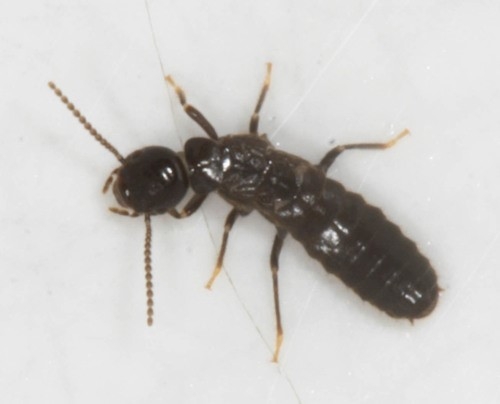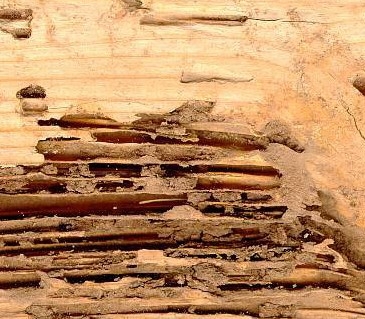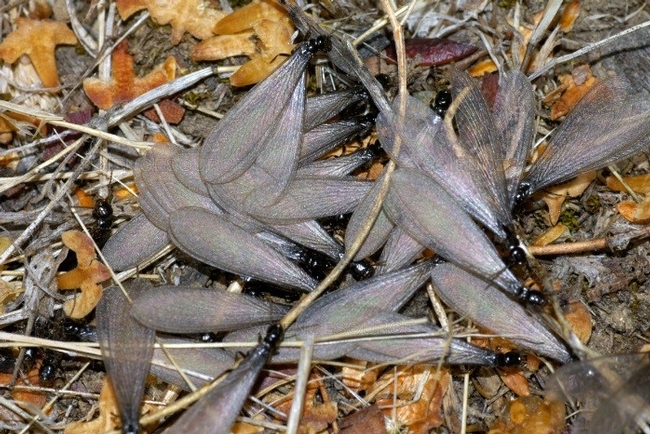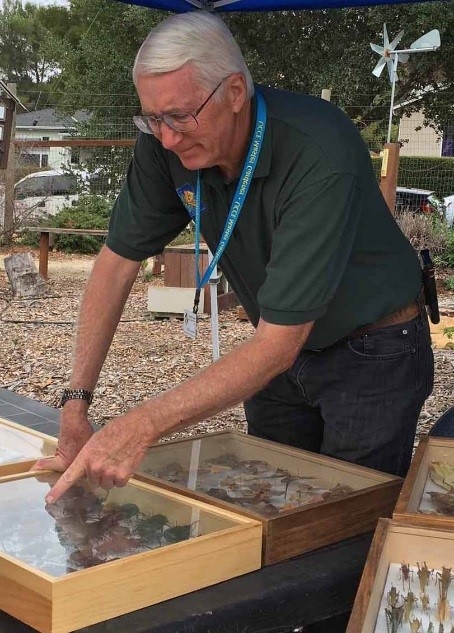- Author: Norman Smith
Norm Knows...
Western Subterranean Termites
Western Subterranean Termites have a winter time activity period, but are year-round pests of wooden structures and dead trees. The winter activity is associated with their swarming habit. The winged adults are black/dark brown with opaque gray wings. King and queen adults will swarm the first warm day after the years first major rain fall. Some of you may have seen the winged adults emerging from a hole in the soil, one after the other, and flying off, but maybe you weren't sure what you were observing. Mating is this activity that allows the termites to spread to other favorable habits.
Kings and queens will pair up, then look for a moist soil situation with wood present, such as 2 X 4's laying on the ground next to the wall of a home, a dead tree trunk and buttress in the garden, or even decorative bark in landscape areas.These can all get a colony started, but the worker termites are seldom satisfied with their initial discovery, and will almost always send out exploratory trails and tunnels to look for other sources of wood. Unfortunately, the wood framing of your nearby house is one of their favorite habitats.
The major portion of the colony and the queen and king are in the soil. Workers must foray back to the soil each 24-hour period, to pick up dirt and certain bacteria, but will then head back up into the above ground structure. Their tunnels in the wood are always lined with dirt from the garden or below the house. The habit of the queen termite residing in the soil and not in the wood source is the main reason that fumigation is not effective for this kind of termite. Fumigation may kill some of the foraging adults in the wood foundation of the home, but not the one termite that can keep the colony going with more eggs and immatures. Termite pest control companies try to put up a toxic barrier between the nest in the soil and the wood source, hoping that as the workers pass through the barrier, they come in contact with the toxin and die. Another control method is to place some poisoned bait wood traps around the home and hope that the foraging workers will discover it and transport the poison wood to the queen.
Termite inspectors will look for the dirt tunnels plastered to the foundation or rising from the soil beneath the foundation. These tunnels should be destroyed by the inspector at the time of treatment so that if more are seen in the future they will know that they were not successful in eradicating the colony.
I saw a stark reminder of the importance of termite control while residing in Fresno. Some of you may remember the Coalinga earthquake. Some of the homes in that town were snapped off their foundations, offset by a foot in some instances. The reason was that some of the homes had weakened wood framing from termite damage and the sharp jolt from the earthquake just snapped the 2 X 4's at their base. Those homes had to be raised and rebuilt. I hope they had good insurance.
Norman Smith was the Fresno County Entomologist for 30 years. He fielded calls from the general public, pest control companies, farmers, PCA's, etc.; ran the insect trapping program, and gave presentations on insects to many different groups, including lots of schools. Norman has developed a 100,000 insect specimen collection for the county over the 30 year career. Norman earned a Ph.D. in Entomology at UC Davis in 1979.
Norman says...I now enjoy working in my garden, traveling with my wife, golfing and bowling, taking insect collecting trips in the US and overseas in the tropics, and working on some personal research of some small wasps. I also enjoy working with and for the Master Gardener program in SLO.








Before replying to your question, it’s important to stress that we cannot be certain that our local species occurs in your region. You may have a relative, but that species will likely have different behaviors.
With that, the only obvious seasonal behavior of our local subterranean termite is the swarming of the reproductives. This occurs usually in the fall after the first significant rain. The day after the rain, usually during a sunny spell, the reproductives will swarm from a hole in the ground for 20 minutes to an hour, likely depending on how large the colony is. Mating soon takes place and the couple will look for wood, or cellulose, that is in contact with moist soil and enter the ground under that material. The amount of wood or cellulose available probably determines whether or not the new colony is successful. Now, in established colonies, the main portion of the colony is in the ground, and workers foray up into the structure on a 24-hour basis. Another possible seasonal activity is if the wooden structure becomes very hot during summer months then perhaps the workers will avoid the heat of the day by leaving the structure before it gets too hot or will stay in the ground until the structure cools down. I suspect this does occur though I have not heard any of our local pest control operators refer to its occurrence. The same behavior is suspected for subfreezing temperatures. Structures that are well insulated may not experience this activity. The fact that the majority of the colony and the queen are in the soil is the reason the subterranean termite is treated by soil injection or bait stations. Fumigation of the structure is not effective for this termite.
Thanks again and best of luck.